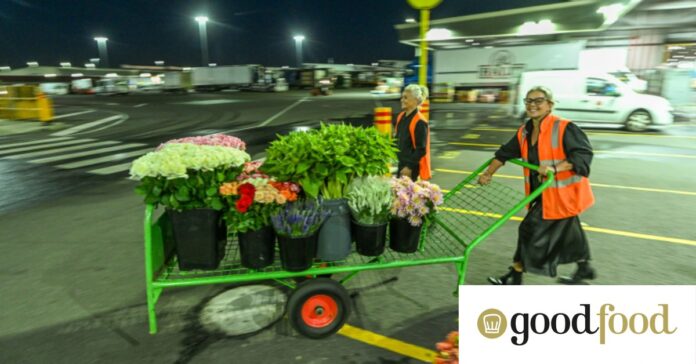[ad_1]
In the northern Melbourne suburb of Epping, a sprawling 19-hectare market trades six days a week – an estimated $2 billion worth of fruit and vegetables moving through its gates. And most of the buying and selling happens before you’ve even woken up.
This is Melbourne Market, one of six markets of its kind in Australia that’s an invisible but important cog in our food system.
“They remain a very important part of the supply chain. Particularly as the market share of the supermarkets increases, they become an absolutely essential alternative path to market [for farmers],” says chair of the National Farmers’ Federation’s Horticulture Council, Jolyon Burnett.
It’s mostly independent greengrocers that use the market, plus wholesalers that supply restaurants, cafes and bars. Buyers for IGA supermarkets are there, but Coles and Woolworths use their own supply chains for the majority of their fresh stock.
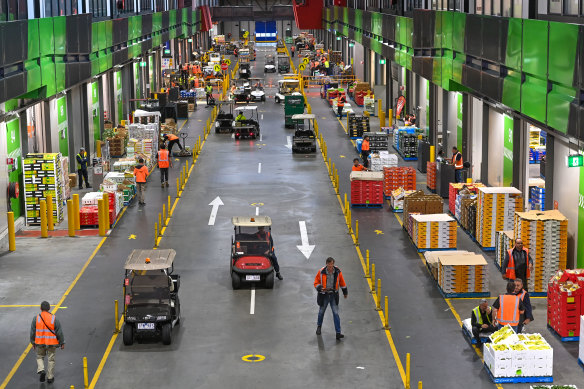
Arriving on a Thursday at 5am, the pace feels frenetic, although apparently the market is winding down.
Most of the 2000 buyers came at 3.30am, examined that day’s produce, made their picks and packed up their vans to get their hauls of fruit, vegetables, herbs and flowers back to shops, restaurants and cafes across the state.
Australians buy 73 per cent of their fruit and vegetables from “the big two”, while the share of produce bought from non-supermarkets has gradually decreased. Their estimated numbers have dropped from 9000 shops in 1960 to 1500 today.
Against the backdrop of multiple inquiries into major supermarket pricing and their dealings with farmers, many people are thinking harder about where they buy their food and the flow-on effects of those choices.
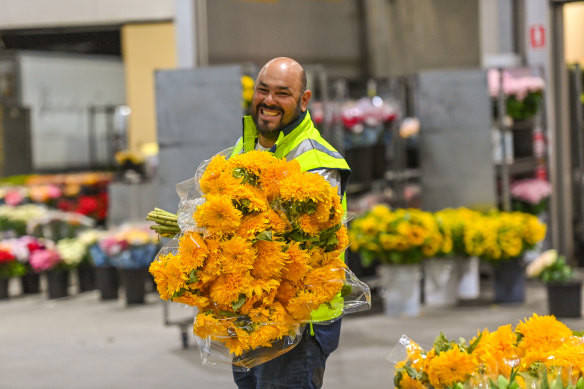
At wholesale markets like this one, which most greengrocers use, farmers can still bring goods they’ve grown themselves and negotiate a price.
“The market price in the wholesale markets is much more transparent,” says Burnett.
“It’s not without its faults, but as you can see what everyone else is selling for, you can get a general sense of what everyone else is buying for, and that knowledge is held pretty equally by everyone in the system.”
If there’s a glut of tomatoes at the end of the season, buyers can get them cheaply and pass that on to shoppers. If a boutique grocer knows its customers want betel leaves, there’ll be a supplier at Epping who’s got them.
“For us who don’t supply supermarkets, this market is 100 per cent critical. How we would sell [without it], I don’t know.”
Nick Patsuris, grower
All that choice, colour and variety is on full display when you walk into the market while it’s still pitch-black outside. Forklifts whiz past carrying pallets of mandarins, cauliflowers, pumpkins and apples. Some are going forwards, some backwards. Other drivers dart in front of them, traders on foot weave in and out, and no one hesitates for a second or crashes (at least not today).
There is a petrol station on-site, servicing the nearly 900 forklifts and 350 golf buggies that zip boxes of lettuce from one end of the market to the other. There are four cafes, operating on upside-down hours: from 3.30am to 7.30am. And there are the people who power it. These are some of them.
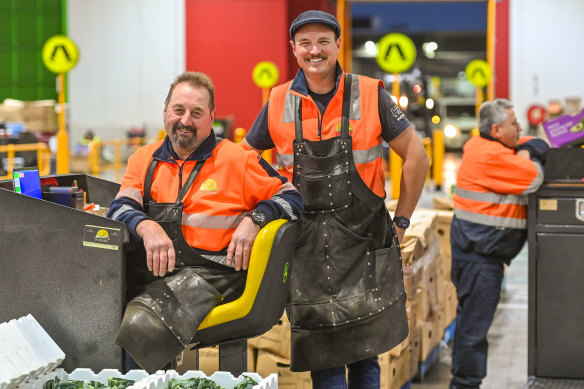
Nick Patsuris, grower, Patsuris Produce
Nick Patsuris and his father, Paul, run one of the approximately 300 businesses that license a stand on the trading floor of the market to sell produce they grow themselves. Their trade is cabbages and cauliflowers, grown in Werribee South. Along with standard white cauliflower, they dabble in a niche line of purple, green and orange-hued caulis.
“We’re usually in here at 11 o’clock at night at our warehouse. We’ll make up all our pre-orders, then once that’s done, we come in here and set up our display. We’re just about getting ready to pack up now. By 5.45am, our morning here is done pretty much. Then it’s back to the farm,” Nick says.
“We try and harvest during the day and then sell it that night, [so] if a fruiterer buys it, it’s not even a day old. It’s as fresh as you’re going to get, bar pinching it off the farm!
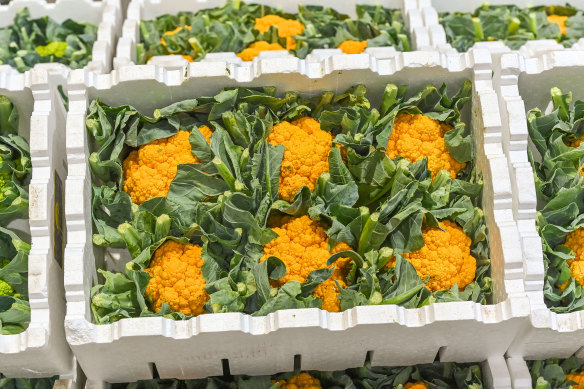
“I’m fourth generation. My great-grandfather bought our property down in Werribee in the late 1920s. Then he and his brothers brought their families out from Greece. Now it’s me and dad. I finished school in 2005, so [I’ve been doing it] 18 years full-time.
“For us who don’t supply supermarkets, this market is 100 per cent critical. How we would sell [without it], I don’t know.
“We sell for other growers as well, mainly from the Werribee area. Not everyone markets their own stuff but we still do. Our neighbour here sells potatoes a couple of days a week, so if he’s not here and someone wants to come and buy, we’ll make the sale for him and vice versa.”
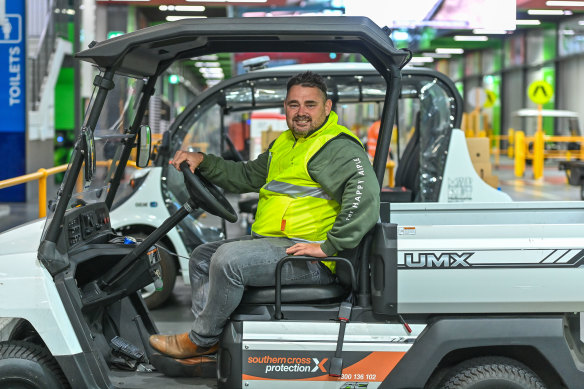
Graham Gee, head buyer, The Happy Apple
Boutique grocer The Happy Apple has stores in Newport, Seddon and Ascot Vale. Its head buyer, Graham Gee, left a career in sales and marketing 16 years ago.
“The hours are a little bit more friendly in marketing, but I really love what I do and the quality of produce I get to deal with. And also the rich characters I meet that are passionate about what they do. I’m always learning from them.
“I probably speak to 70 or 80 farmers every day, if you count being on the floor at the market. Today, for example, one of them said, ‘I can’t supply you coriander tomorrow’, so then I talk to someone else. They’re telling me in real time what’s happening.
“I try and gain information everywhere I go. Knowledge is power. It allows me to let my staff know what’s going on, so they can then let our consumers know.
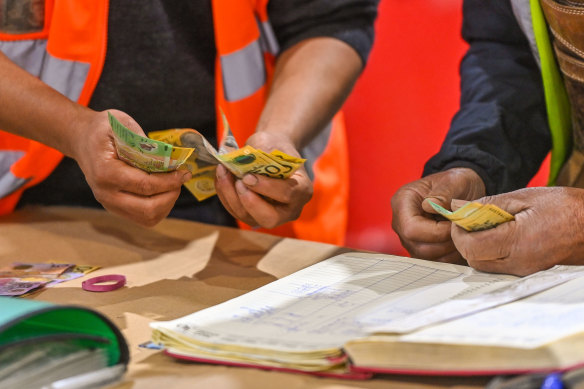
“I’m typically at the market four days a week. I like to have a 60- to 90-minute nap in the afternoon. That’s usually about 2pm. Bedtime is 8.30pm.
“A good morning for me is finding the stuff I need and the quality I need, but every morning’s different, too. That’s the thing about this industry.
“You want to make sure that everything is coming through well. The weather is something you have to keep a very close eye on these days.
“Produce does self-regulate in a way. If there’s a surplus of stuff, things will be cheaper and retailers need to pass that on, in order to get the volume through. It’s very much economics 101.”
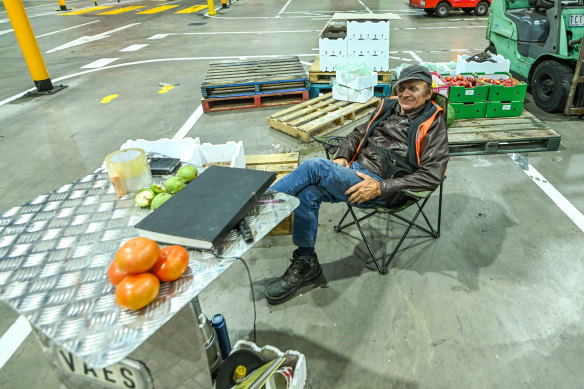
Bill Gogas, owner, VAES
“I come down from Mildura every Thursday to sell my pistachios, walnuts, olives, pomegranate and prickly pear,” Bill Gogas says.
“I drive to Melbourne the night before and I’m usually here from 2am to 5.30am, and then I’ll drive back.
I’ve been doing this pretty much all my life, since I was 35 years old. That was 1975. Now my daughter comes and helps me.
I sold everything today.”
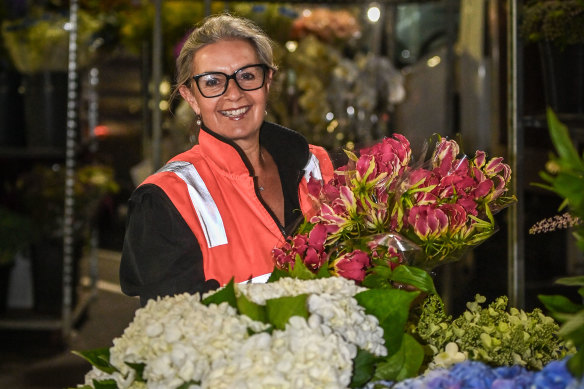
Victoria Whitelaw, founder, Victoria Whitelaw Beautiful Flowers
“My mother was a florist and I was never going to do it, but I fell in love with it and here I am, still going, 37 years later,” Victoria Whitelaw says.
“I would not do another thing.”
Whitelaw is one of about 800 flower buyers who come to Epping’s 12,000-square metre flower market early each day.
“One of the beautiful things [about this job] is seeing the sunrise,” she says.
“I get up at 1.30am and go to my shop to have a meeting with the other buyer coming with me that day. Then we drive to Epping and we start buying.
“I walk around several times, then I go to the stands and choose what I want. Then we start collecting and take the flowers to where our truck is parked and start allocating them to the three different shops we have.
“There’s a shop on site where we can get all our sundries such as plastic wrap. There are plants and foliages as well as the flowers. You can get everything in one go.
“Every single sale we have in my business, it’s an emotional sale for clients. Whether it’s a sad occasion, a happy occasion, just to say hello or just for home, it’s an emotional sale. That’s a really special thing.”
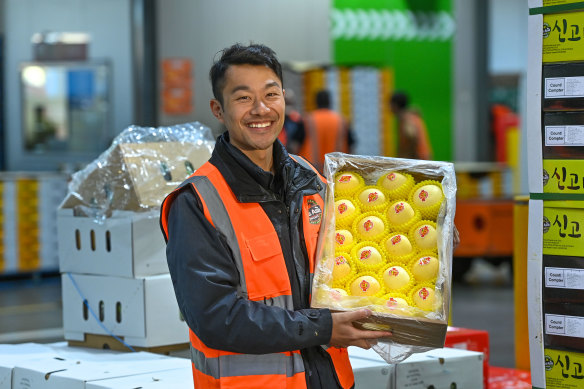
Thanh Truong, sales and operations manager, Aus Asia Produce
“Most mornings, I’m getting in here and making sure that the stock’s good, especially things like leafy greens. There’s been a lot of weather in Victoria so a lot of fruit isn’t holding up,” Thanh Truong says.
“The sun’s rising now, so most of the trucks have already gone.”
Truong (who calls himself “the fruit nerd”) is the second-generation of his family to run Aus Asia Produce, the wholesale and import business his dad started in 2003 after running a fruit stall in Springvale for many years.
“My dad became a wholesaler because he couldn’t source culturally relevant produce, such as Thai basil or nashi pears, so he had to speak to farmers to convince them to grow it. This was the late ’80s,” Truong says.
“The first thing he got grown for him was a nashi pear. He’d travel to Shepparton to pick up nashis twice a week. Ironically, he’d travel along the same road [Melbourne] market is now on.”
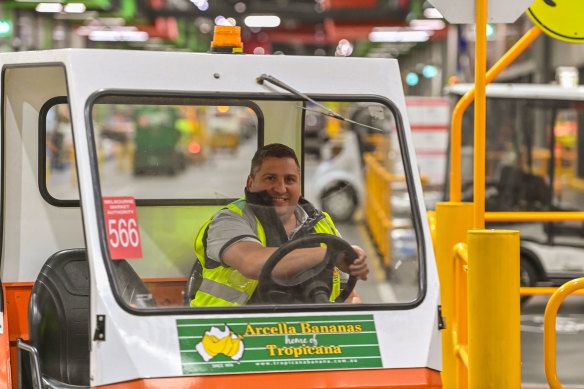
The biggest sellers for Aus Asia today are drinking coconuts, water spinach, garlic, Thai basil, and pears, particularly nashi pears.
“It’s very seasonal but the volume of produce we sell varies between 50 tonnes to 150 tonnes a week,” Truong says.
“We’re constantly trying to service community. That’s originally what my dad set out to do. I’m certain pretty much everyone in here – the Italians to the Lebanese to the Greeks – started growing the things they had back home, like tomatoes, zucchini, capsicum. And that’s created our diverse food culture.
“For me, the best part of the market isn’t just the people, it’s all the different types of produce and the things you can learn. But you have to ask questions. What you see on the floor is not even 10 per cent of what we have. We have over 200 pallets behind what’s on display.”
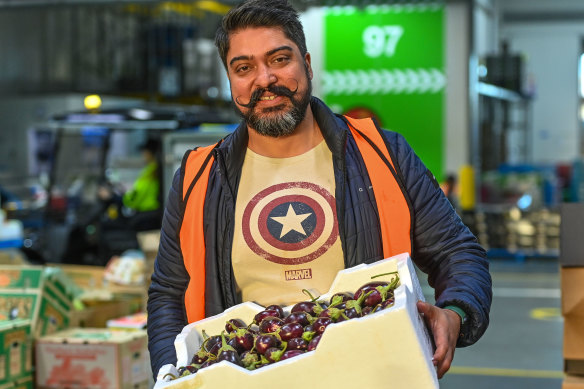
Top tips for choosing produce and finding value
Knowing how to choose good produce is a passion for Thanh Truong, who has written a book designed to share what he’s picked up from a long career buying and selling fruit and vegetables.
“We’ve been deceived by our own eyes. We’re not trained to look for a good eating fruit, we judge it on good looks,” he says.
On mandarins, Truong suggests choosing two mandarins of the same size and comparing their weight in your hand. The heavier one will have more water content and be juicier. Use the same test when choosing oranges. You should also avoid oranges that are very firm.
Apples are in season which means you can buy them at peak flavour and freshness. From The Happy Apple, Graham Gee’s tips for choosing apples are to look for firm skin with no visible blemishes.
Until July, you may see unwaxed apples which haven’t been treated to preserve them for long storage. “They look a little bit duller, but they’re pretty much as mother nature sent them out,” says Gee.
If value is most important to you, try going to a different shop for your fruit and veg one week. You might find better deals than at your usual place.

Graham Gee has a few best buys and things to watch out for right now when shopping for produce.
Good quality and good price:
- Grapes, especially late-season varieties including sweet globe and autumn crisp
- Apples, but wait a couple of weeks for pink ladies
- Shepherd avocados (the green-skinned variety). “Don’t be scared of these. You can’t tell ripeness by the colour of the skin but just feel around the top of the fruit and make sure it’s not too hard.”
- Pumpkin including kent, butternut and Queensland blue
Keep an eye on:
- Mandarins and oranges are still a few weeks away from their prime
- Cabbages are in short supply and therefore expensive
- Broccoli continues to be expensive
Overall:
“Shop with your eyes,” says Gee. “See what’s good and what the big displays are [at your grocer]. They’re generally going to be the best price and best value for money.
“When you’re doing your grocery shopping, don’t focus on things that are out of season and expensive. At the moment, for example, steer away from stone fruit and berries. Focus on things like apples, grapes and pumpkin that have a lot of volume.
“The other tip is to buy quality. It’s a false economy to buy something that’s really cheap but you might only be able to eat half of it.”
[ad_2]
Source link


